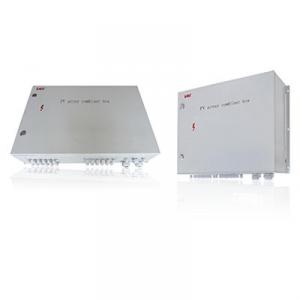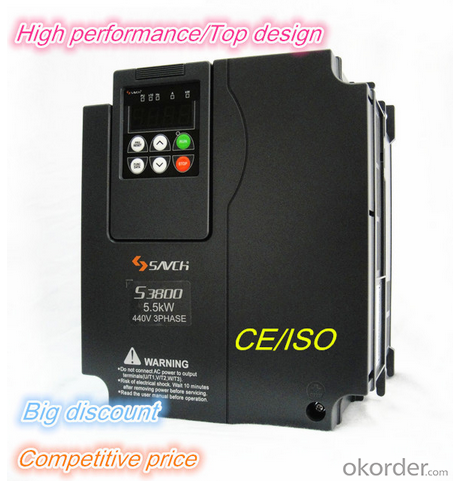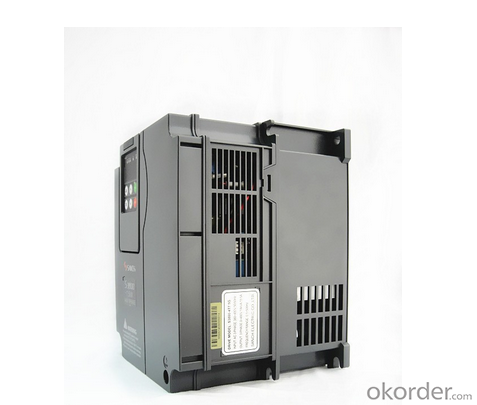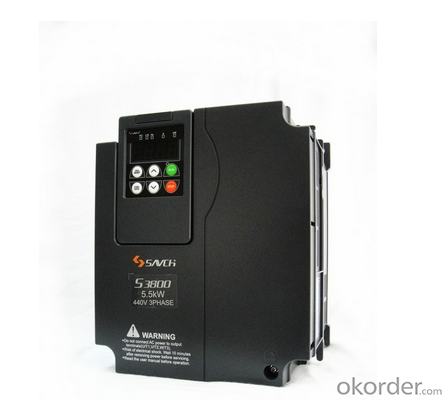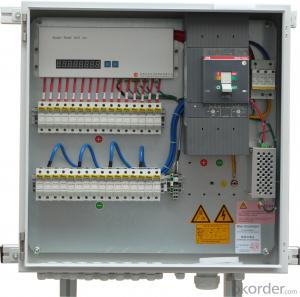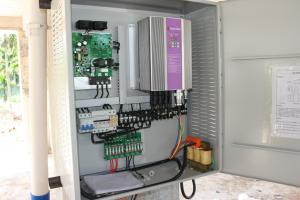Solar Inverter Rack - On-Grid PV Combiner Box for Easy Maintenance and Enhanced Reliability
- Loading Port:
- China main port
- Payment Terms:
- TT or LC
- Min Order Qty:
- 10 carton
- Supply Capability:
- 20000 carton/month
OKorder Service Pledge
OKorder Financial Service
You Might Also Like
EAPVCB-08/16/18S
To reduce the connection cables between the PV modules and solar inverters, to maintain easily, and improve reliability, in the large-scale photovoltaic power plants of on grid system, it’s necessary to use DC combining device between PV modules and solar inverters. EAPVCB Series PV array combiner box is specifically designed for high performance and high reliability, working with the PV inverter products from East Power to form complete photovoltaic system solutions. With PV array combiner box, and based on the PV inverter input voltage range, users can use certain numbers of PV panels with same specification in serially to form a PV module and connect several PV modules into the combiner box, and going through the SPD and breaker to output, which makes it easier to connect with inverter and also reduced the system installation time.
● Water protection level is IP65 for outdoor installation
● Wide range of DC input voltage (Max input open voltage can be up to 1000V)
● Dedicated photovoltaic fuses are used in each input,can bear DC1000V,fuse current can be selected
● Each input fuse is with a fuse holder, easy to replace and repair.
● Special high-voltage PV SPD is used,both positive and negative circuit can be protected
● Golden Sun and CE certifications
Model | EAPVCB8S | EAPVCB16S | EAPVCB-18S | |
Max PV array voltage | 1000V | 1000V | 1000V | |
Max input ways | 8 | 16 | 18 | |
Fuse rated current | Depending on customer's requirement | |||
Output terminal | PG29 | |||
Protection level | IP65 | |||
Environment temperature | -25℃~+60℃ | |||
Humidity | 0~99% | |||
W×H×D | 700×575×230mm | |||
Weight | 26Kg | 30Kg | 30Kg | |
Standard configuration | ||||
DC output breaker | Yes | Yes | Yes | |
PV-specific lightning protection module | Yes | Yes | Yes | |
Anti-reverse diode module | No | No | No | |
Diffuser | No | No | No | |
Fan | No | No | No | |

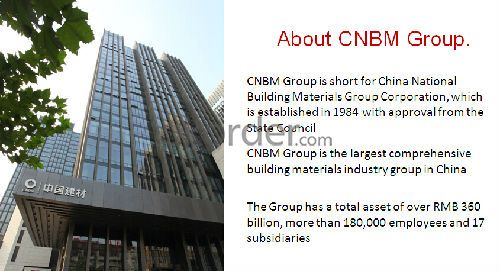

· Q. What's lifetime of a UPS ?
Most plug-in UPS are workable for at least five years. We'd advise you to change the batteries every three to four years. For larger equipment, we maintain equipment for twenty years old and still going strong.
· Q. How to maintain a UPS ?
There are three simple methods: Never overload your UPS, never connect any home electronic devices such as cooling fan to your UPS. This may cause malfunction of your UPS. Discharge the battery in a consistent interval, once a month or once two months. You can do this by turning on the UPS without connecting the mains.
- Q: How does a solar inverter handle power quality disturbances?
- A solar inverter handles power quality disturbances by monitoring the incoming power from the solar panels and adjusting its output accordingly. It uses various control mechanisms to regulate voltage and frequency, ensuring that the power generated by the solar panels is synchronized with the grid. This helps in maintaining a stable and high-quality power supply, minimizing the impact of disturbances such as voltage fluctuations or frequency variations. Additionally, some advanced solar inverters also offer features like grid support functions and reactive power compensation to further enhance power quality.
- Q: How does a solar inverter handle harmonics in the grid?
- A solar inverter handles harmonics in the grid by incorporating a built-in filter that helps mitigate the impact of harmonics. This filter is designed to reduce the distortion caused by harmonics, ensuring that the inverter's output adheres to the required grid standards. Additionally, advanced inverters may also employ control algorithms that actively monitor and adjust the output waveform to minimize harmonic distortion and maintain grid stability.
- Q: What is the role of a grid-tie inverter in a solar PV system?
- The main purpose of a grid-tie inverter in a solar PV system is to convert the DC electricity produced by the solar panels into AC electricity that can be utilized to supply power to electrical devices in homes or businesses. In a solar PV system, the solar panels generate DC electricity when exposed to sunlight. However, most residential and commercial establishments require AC electricity, which is the standard form of electricity provided by utility companies. This is where the grid-tie inverter comes into play. The grid-tie inverter takes the DC electricity generated by the solar panels and transforms it into AC electricity that is compatible with the electrical grid. It ensures that the electricity produced by the solar panels is synchronized with the utility power and can be seamlessly integrated into the existing electrical system. One of the primary functions of a grid-tie inverter is to match the frequency, voltage, and phase of the AC electricity generated by the solar panels with that of the utility power. This synchronization is crucial to guarantee a smooth flow of electricity between the solar system and the grid, and to prevent any interruptions or harm to the electrical system. Furthermore, a grid-tie inverter also serves as a safety monitor for the electrical grid. It continuously checks for any voltage or frequency fluctuations in the grid and can automatically disconnect from the grid in case of a power outage or grid failure. This feature is important to ensure the safety of electrical workers who might be repairing the grid during an outage. Additionally, a grid-tie inverter enables net metering, which is a billing arrangement where surplus electricity generated by the solar system can be fed back into the grid. This means that if the solar system produces more electricity than is being consumed, the excess energy can be sent back to the grid and the homeowner or business owner can receive credits for the surplus energy produced. This can help offset energy costs and potentially result in financial savings. In conclusion, the grid-tie inverter plays a crucial role in a solar PV system by converting the DC electricity generated by the solar panels into AC electricity that can be used to power electrical devices, ensuring synchronization with the electrical grid, monitoring the grid for safety, and enabling net metering for potential financial benefits.
- Q: How do you calculate the maximum power point current for a solar inverter?
- To calculate the maximum power point current for a solar inverter, you need to determine the optimal operating voltage and current at which the solar panel can produce the maximum power. This can be done by using a technique known as the perturb and observe (P&O) algorithm. The P&O algorithm continuously adjusts the operating point of the solar panel by slightly perturbing the voltage and observing the resulting change in power. By tracking the voltage and current values that yield the highest power output, you can calculate the maximum power point current for the solar inverter.
- Q: How does a solar inverter convert DC power to AC power?
- A solar inverter converts DC power to AC power by utilizing a two-step process. First, it converts the DC power generated by the solar panels into a high-frequency AC current. Then, it uses a transformer to increase the voltage and shape the AC waveform to match the grid's requirements. This process allows the solar energy to be fed into the electrical grid or used directly in homes and businesses.
- Q: What are the potential risks of over-discharging a battery connected to a solar inverter?
- The potential risks of over-discharging a battery connected to a solar inverter include reduced battery lifespan, decreased storage capacity, increased internal resistance, and potential damage to the battery cells. Over-discharging can lead to deep cycling, which can degrade the battery's performance and shorten its overall lifespan. It may also cause the battery to lose its ability to store energy efficiently, resulting in reduced storage capacity. Additionally, over-discharging can increase the internal resistance of the battery, leading to decreased efficiency and lower power output. In severe cases, over-discharging can cause irreversible damage to the battery cells, rendering them unusable and necessitating replacement.
- Q: What is the warranty period for a solar inverter?
- The warranty period for a solar inverter typically varies depending on the manufacturer and model, but it commonly ranges from 5 to 10 years.
- Q: Can a solar inverter be used in commercial applications?
- Yes, a solar inverter can be used in commercial applications. Solar inverters are designed to convert the direct current (DC) generated by solar panels into alternating current (AC) that can be used to power electrical devices and appliances. This makes them suitable for a wide range of commercial applications such as offices, retail stores, factories, and other commercial buildings where solar energy can be harnessed to reduce electricity costs and promote sustainability.
- Q: How does a solar inverter impact the overall system reliability?
- A solar inverter plays a crucial role in ensuring the overall system reliability of a solar power system. It converts the direct current (DC) generated by solar panels into alternating current (AC) that is suitable for use in homes or businesses. By efficiently converting the energy and maintaining optimal voltage and frequency levels, the inverter ensures that the system operates reliably and consistently. It also provides various protective functions, such as monitoring and controlling the system's performance, detecting faults or abnormalities, and shutting down the system in case of emergencies. Therefore, a well-functioning solar inverter significantly impacts the overall system reliability by maximizing energy production, preventing damage, and ensuring smooth operation.
- Q: Can a solar inverter be used with a solar-powered remote sensing system?
- Yes, a solar inverter can be used with a solar-powered remote sensing system. The solar inverter is responsible for converting the direct current (DC) generated by the solar panels into alternating current (AC) that can be used to power the remote sensing system.
Send your message to us
Solar Inverter Rack - On-Grid PV Combiner Box for Easy Maintenance and Enhanced Reliability
- Loading Port:
- China main port
- Payment Terms:
- TT or LC
- Min Order Qty:
- 10 carton
- Supply Capability:
- 20000 carton/month
OKorder Service Pledge
OKorder Financial Service
Similar products
Hot products
Hot Searches
Related keywords
